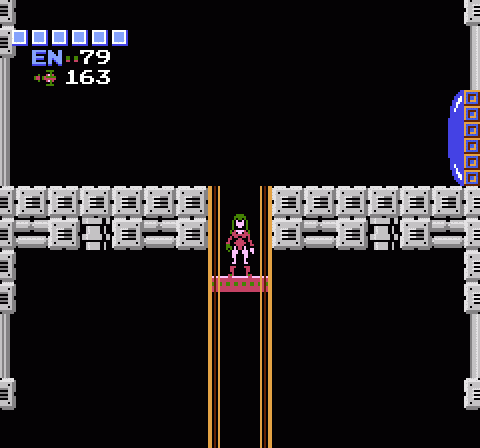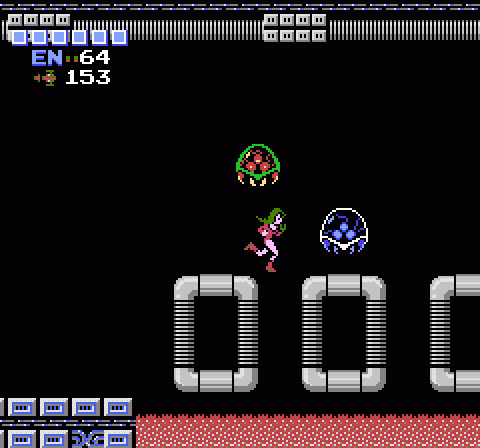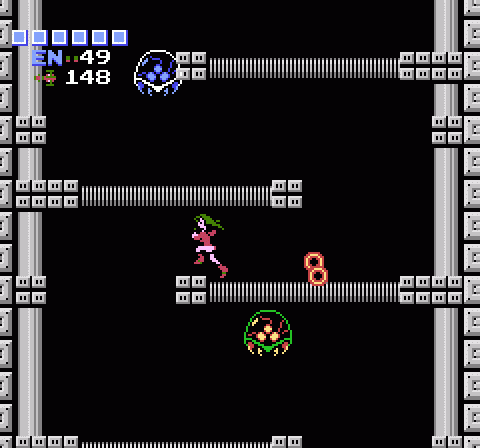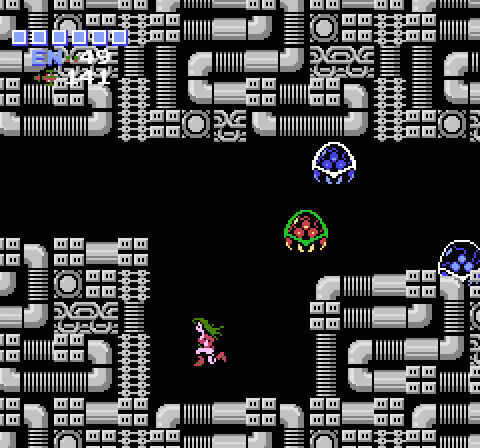The player’s arrival in Tourian (the final zone where the Mother Brain awaits) is accompanied by a shift in tone. The visuals are stark and mechanical, a contrast to the natural formations and ancient constructs of the rest of Zebes’ underground. Even more strikingly, the background music ceases to be musical and instead adopts the dissonant sound of random computer noise. Clearly, this space represents the enemy’s true lair, a futuristic expansion on the existing natural labyrinths designed for the cybernetic enemy leader. The message should be clear: “This is it.”

Once you step off the elevator into Tourian, another difference makes itself apparent. This zone contains neither minor enemies nor any need to explore. It’s a totally linear path to the end, and only two kinds of foes appear: The small energy toruses called Rinkas, and the creature from which the entire franchise derives its name, the Metroid.
Metroids represent a different kind of enemy than has appeared to this point — not just for this adventure, but for games as a whole. The closest contemporary analogue I can think of is Ghosts ‘N Goblins‘ Red Arimer: They’re smart, aggressive, fast, and utterly deadly. Unlike the other creatures that populate the corridors of Zebes, Metroids don’t waffle around with fixed paths or aimless meandering that makes a minimal sort of effort to drift in the direction of Samus. They lurk in wait at fixed points, and the instant Samus comes into their range (coincidentally, this range is marked exactly by the edge of the screen) they dart forward quickly to attack.
As for their attack, they don’t settle for simply bumping into Samus and knocking x number of points off her health total. Instead, they latch on like parasites and begin draining her energy. A Metroid is never sated, so it will cling to Samus until she’s dead. Up to three Metroids can appear on-screen at once, some more aggressive than others, but all intensely dangerous. The one upside to Metroids is that the the health and Missile refills they drop are worth several times as much as normal refills… though even with the Varia, enemies here hit for 15 points of health, so it can be tough to keep ahead of the power drain once Rinkas appear. Heck, the first one to materialize actually spawns as Samus is passing through a door and hits her while she’s locked in a screen transition — a free hit just to say “screw you.”

Once you descend a few rooms into Tourian, the Rinkas start to appear alongside the Metroids. They spawn infinitely from various points around the room, and the screen always has three at a time. Like Kraid’s spikes, you can freeze them to take them briefly out of play; if you destroy them, another will immediately respawn to take its place… and there’s always a chance it’ll respawn directly under Samus’ feet, meaning it’s much less dangerous to simply freeze them. That’s more easily said than done when Metroids are closing in on you, though.
What makes Metroids particularly dangerous is that they only have a single weakness: Ice. (Later games explicitly call out their vulnerability to cold, meaning any possibility of hand-waving the improbable physics of the Ice Beam’s freeze effect as zero-point gravity or stasis or something is right out… not that it matters in any way, shape, or form.) You can push a Metroid away with Missiles or the Wave Beam or the Screw Attack, but these weapons don’t actually harm the creature. Only by freezing it does it become vulnerable, and only then to five Missiles.
So, the strategy for this area becomes fairly straightforward in concept: Inch forward to lure a Metroid from hiding, freeze it, pump it full of explosives until it dies. Dodge or freeze Rinkas when necessary. Repeat. This is more easily said than done, however, given the high speed and unconstrained motion of the Metroids. They can attack from any angle, swooping in from above or below in a split second to latch onto a tasty Samus-snack. And you’re often descending vertical shafts into Tourian, meaning they’re coming up from beneath you and hovering hungrily beneath your feet, a tiny platform the only thing separating Samus from safety and a brief future of shriveling into a dusty husk of former humanity.

Metroids “pace” beneath you, drifting slightly back and forth until they get a clear shot, a behavior you can exploit to lead them up as you back away and line up a clean shot. Thankfully, when a Metroid latches onto Samus, it briefly moves down to her level to line up its mandibles or whatever, so you have a brief instant of contact in which you can freeze it before it surrounds you. If you’re too slow, however, the Ice Beam becomes useless. When a Metroid begins draining Samus’ health, she can only run back and forth while waiting for the inevitable. The only way to dislodge a Metroid is to duck into a ball and lay down some bombs, then roll over them and hope the angle of the blast knocks the creature free. This gives you only a sliver of a reprieve, however, as the Metroid will be stunned for a fraction of a second before shaking off the blast and moving back in for another nibble. This gives you just enough time to stand and freeze it.
Metroids create a harrowing sensation like nothing else in the game, especially once they start to appear several at a time. Until you know the trick of defeating them, they’re utterly baffling in their sheer deadliness and persistence. Their intensely aggressive nature combines with their unique life-sapping properties to create a wholly unique kind of foe. According to designer Yoshio Sakamoto, the name “Metroid” comes from “metro” (as in subway) and “android” — that is, the robotic-looking Samus is exploring underground tunnels like a subway. But it’s wholly fitting that the game’s creators gave these distinctive foes the name, because they’re far and away the most frightening and dangerous aspect of the adventure.

It can be a shock of cold water to go from aimless exploration in low-threat environments to a final run-up through Tourian’s brutal Metroid gauntlet, but this area forces players to use both their wits and all the combat skills they’ve picked up along the way to survive.
The aggressiveness of the Metroids caught me off guard the first time I made it to Tourian. I’d been lulled into a false sense of security by Super Metroid where they’re a bit slower and can be dispatched easily by the Wave Ice Beam.
I also getting stuck with a Rinka during a door transition is the worst thing ever.
Hmm, so it’s the angle of the bomb blast which jars them loose? I did not know that.
Also, aren’t Metroids incapable of respawning? I might be thinking of a different installment, but I thought that once you killed a Metroid, it was dead, even to the point of carrying over into passwords. Again, I might be thinking of a different game in the series, though.
No, the Metroids respawn if you continue. A pretty decent strategy for a low-missile run is to destroy all the Zebetites in Mother Brain’s room, die, and start over at the beginning of Tourian. If you play carefully, you’ll restock your health and missiles enough to win with the Metroids’ drops.
Hmm, okay; maybe it was the Zebetite I was thinking of.
Now comes a big admission: Tourian in the original Metroid was one of the few places in video games that scared me so much as a kid that I needed my dad to hold me to play it.
It was a huge nuisance, not only because it was one of the few gaming moments I couldn’t play alone back then, but because there are two big reasons you should be willing to hang around Tourian for a while:
One, Metroids are by far the fastest way to recharge health and missiles. They’re several times faster than using Brinstar’s enemies to do it. There is a chance you’ll run out of missiles since missile pickups are random, but you can just go back up to the last room of Brinstar to get a few.
Two, you should attack Mother Brain’s room in two phases. First get rid of all the Zebetites (the red tubes), then go back to the Metroids, recharge to full health and missiles, then go after Mother Brain herself.
Since scared, little Vega wanted to rush through Tourian as fast as possible, he had to slowly grind for health and missiles in Brinstar, then accomplish the crushing task of beating mother brain’s entire room in one go.
It makes me wonder: Since the game remembers that the Zebetites are gone even when you leave the room, does it also remember that Kraid and Ridley’s health are partly depleted if you leave their rooms before beating them?
This has been quite an entertaining read. I think that it might be time to finally sit down and beat Metroid. There has always been a little bit of guilt for never finishing the first game. Especially since I have beaten the rest of the series numerous times.
If you have it on 3DS, I recommend that version. Save states on a proper console (not PC emulator) are wonderful.
Did it say in the instruction manual how to kill the Metroids? Because I remember knowing exactly how to fight them but I don’t recall if I heard about it from a friend or just did my homework.
Yup: “Freeze it with the ice beam, and then fire 5 missile blasts at it.”
http://www.metroid-database.com/m1/manual.php
Metroid 2 on the Game Boy did a pretty good job of replicating the creepy, unsettling and oppressive feel of Tourian through the whole game. The claustrophobic and desolate tunnels and caverns, the wonderfully weird background noises instead of music, the inherently dark visuals provided by that green screen, plus the anticipation of finding a Metroid shell and knowing than an evolved form lurked nearby was all very scary. That was a great sequel that instead of replicating the original formula gameplaywise seemed to continue from where the first one left off. I hope you will dissect that monochromatic masterpiece next! The Spider Ball was awesome…